|
Kyogi-karuta
1.What you need
A. person & cloths : Need three people.
Two people are as players and one person as a reader. Uniform is only required for special occasions
and players usually wear t-shirt and pants. If you want, you may put on supporters on your knees.
B. card : Need 200 cards.
We always use a set of the official card to play, and also you might use an unofficial card sold in a toy store but we rarely do.
C. the field : The tatami-room
In the room, need 3 tatamis for one pair to play. It is also possible to play on a wooden floor or on a carpet. But it is hard to sit on the wooden floor and
it is hard to sweep the card cause of scratching on the carpet, so playing on the tatami will be the best field with its atmosphere.
2.How to put the playing card
A. The playing cards are used 50 cards of the 100 cards.

To start with players sit face to face and bow one another then mix well 100 cards faced down.
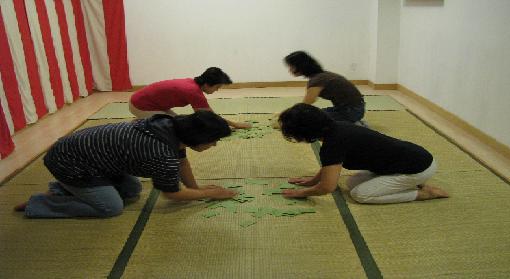
Players mutually take 25 cards and
these are in their hand.

Rest of 50 cards unused is put away in a box and put it beside a player. But unused 50 cards will become influential cards as a play.
B. How to put the playing card.
Each of the players put 25 cards in front of them. The players put them toward themselves and inside of 87 cm in width and 3 rows,
in order as shown in figure below. So cards of Opponent site are the other way around.
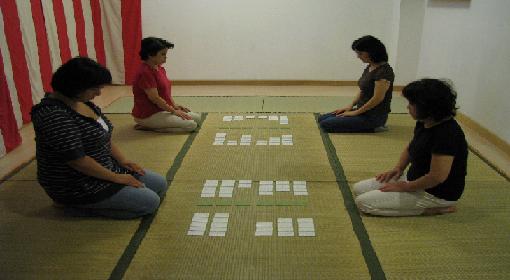
Own cards are placed in 3 rows and opponent cards are 3 rows . It is called Own site
to be put own cards and Opponent site to be put opponent cards. The cards of each row are called “The top”, The middle and The bottom.
The space of each row is 1 cm and the space of the "Own site" and the "Opponent site" is 3 cm have been decided.
In the figure above, both players divide own cards from side to side. On the rule, such regulation is not, so players may freely
put cards in the center. But almost every player divides cards from side to side. Such dividing will be the most standard way to aim
for the way to take faster for own and not for the opponent player.
C.Fixed place
Every player has own spot beforehand to put each card. This is the "Fixed place".
This "Fixed place" also will aim for the way to take faster for own and not for the opponent player. Even cards in the "Own site",
the easiness to take is different at all on the places.
Generally, though it is said that the right side of “The bottom” can be taken earliest by a right-hander, concerning other places,
favorite places are various by every player. With consideration this, the "Fixed place" has been made by each player, so every Fixed place is individual at all.

three cards was put outside in for placing cards in 3 rows are flip and placed their Fixed place.
Well, the arrangement has been finished.
Let's memorize them from now on.
3. Memorizing
A. Memorize 100 poems
On premise, players must memorize 100 poems. Not only memorize them but also as soon as see the card, recognize it.
For instance, when you see the card below,
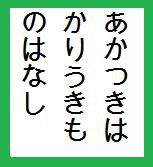
‘ありあ’ which is 5,7,5 part of that poem, comes into your mind. It seems as if when you see your friends, you recognize their names.
The name of this card is ‘ありあ’.
ありあ
[ʌ
li ʌ]
[ʌ]=study [li]=list [ʌ]=study
ありあけの つれなくみえし わかれより
( 5,7,5 part .)
あかつきばかり うきものはなし
(7,7 part . It is a playing card. )
Players tie the top part of the poem and the card by like this and remember.
When saying more accurately, 5,7,5 part of the poem as its name is not whole part of it but first several letters of it. It is called the Settle word.
We will explain later about the Settle word..
B. Memorize 50 Cards
Well, let’s return to the rule of the play.
Before start the play, there is a memory time of 15 minutes.
Player firmly memorizes 50 cards in both sides for the time. It is not only memorize them aimlessly, but also think about practical movement for
the play by the noting of the Family cards and Influential cards.
While memory time, player may leave there without making noise and keep keeping quiet because another player is concentrating on the memory.
There is a signal of last 2 minutes of the memory time that is the time of swinging the right arm in the air.
Now, the play will finally start when the memory time ends.
When the reader told the memory time end, players bow each other and then to the reader.

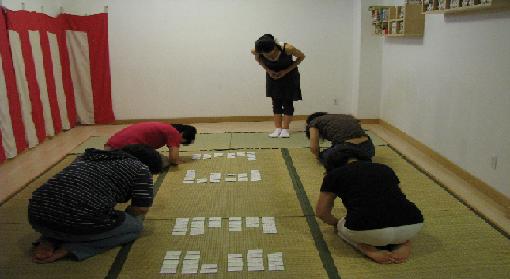
4. Reading
A. The Prologue poem
There is no rule which poem is read as the "Prologue poem", however 全日本かるた協会(All Japan Karuta Association?) has designated
「なにはずに さくやこのはな ふゆごもり いまをはるべと さくやこのはな」
, and this poem has been used in the competition among many part of the country.
B. How to read
In “Kyogi-Karuta”, there is a tidy method for reading, and now let’s explain it easily.
As a basis, when the reader has read 5,7,5 part of a "Reading card", players sweep the “Playing card” as soon as possible.
The reader dose not read 7,7 part of it at this time.
After players put together back the “Playing card” swept, the reader reads 7,7 part of it and at once reads the top part of a next “Reading card”.
For example, previous card is 「あらざらむ・・・」and next one is 「すみのえの・・・」.
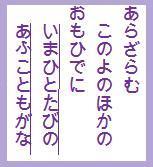  
Ready to next, the reader reads 「いまひとたびの あふこともがな」 that is 7,7 part of
「あらざらむ・・・」, and at once reads 「すみのえの きしによるなみ よるさえや」,
but lengthens [あ] of the last note of [な]
for 3 seconds (reverberation) and after 1 second interval, reads at a stretch until the "Settle word" of 5,7,5 part of 「すみのえの・・・」.
Audience must not make a noise or move at this time because player concentrates this moment for instance determines 「す,Su」
by the consonant [s], occasionally「さ,Sa」, 「し,Shi」,「せ,Se」.
5. Playing
A. Ready position to play
Players are each other sitting (to sit on one’s heels) in front of the cards placed in 3 rows.
The reader starts reading 7,7 part of a card and player takes the Ready position.
Although this Ready position is vary between players, basically a right-hander holds
the right hand like holding a pencil and puts it
on the outside and middle of the bottom line of the own site, puts the left hand on the left-end to support the body,
opens legs a little and pushes the right knee slightly backward.
B. To taking
As soon as a card is read, touching the card whose name is the Match card directly or sweeping the Match card away
to the outside of the field over the field-line is to take a card.
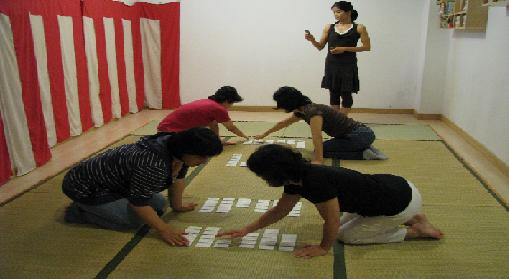
The field-line is a line that is the most outside of the setting cards placed by both players. So the line of 87 cm
in width and 3 rows that showed before is the field-line of each site.
To sweep the Match card away over the field-line is to be pushing the Match card out by sweeping other cards away.
This is one big difference from common Karuta. So in Kyogi-Karuta, it is not the Misstouch when touching any card within the same site of the Match card.
C. Sweeping
When taking a card, there is no especially rule that how touching or sweeping. It may flick or sweep dramatically. However, it needs to do the way of the fastest Taking to win the game.
This is the Sweepway.
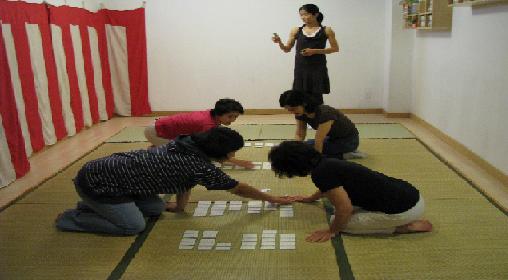
From taking Ready position, reaching right hand as fast as possible to the Match card, its arm goes through without stopping on it.
As soon as it went through and came back to the side, hit on the tatami to make a balance as falling forward if does not.
Most players take most cards with this sweepway.
Swept card flies away into the distance more than expecting. Be cautious when a window was opened, it might fry away outside and also it might run into a sliding paper door.
6. Win & loss
A. The way to the win
The win and loss in “Kyogi-Karuta" which started with 25 cards on the each site determines the win to the player being no card in the own site.
Players can take a card of cause in the both site of own and opponent.
When to take a card in the own site comes to the win cause a card decreases from the own site.
On the other hand, when to take a card in the opponent’s site, by sending a card freely to the opponent site, goes to decreasing cards in the own site.

As decreasing cards doing like this, finally a player won when to be no card in the own site.


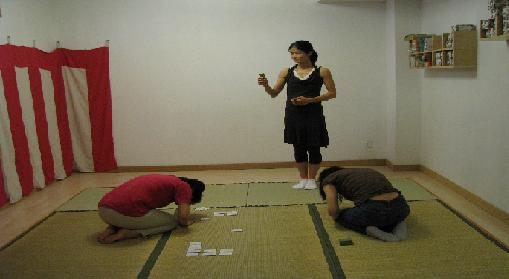
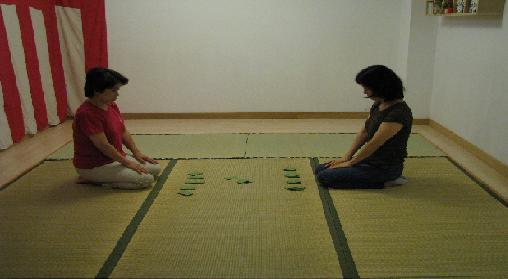

B. Misstouch
As talked a little while ago, it is no problem to touch any card in the same site of being the Match card. But touching any card in the site of not being
the Match card becomes Misstouch, and so, one card will be sending by the opponent player.
For example, in case one another have 10 cards left, the opponent will send one card on the Misstouch. So that it becomes 9 versus 11 at once allow
the opponent player leads in 2.
the Misstouch becomes an important matter at many occasions to determine the outcome.
Top ‖ Above
|